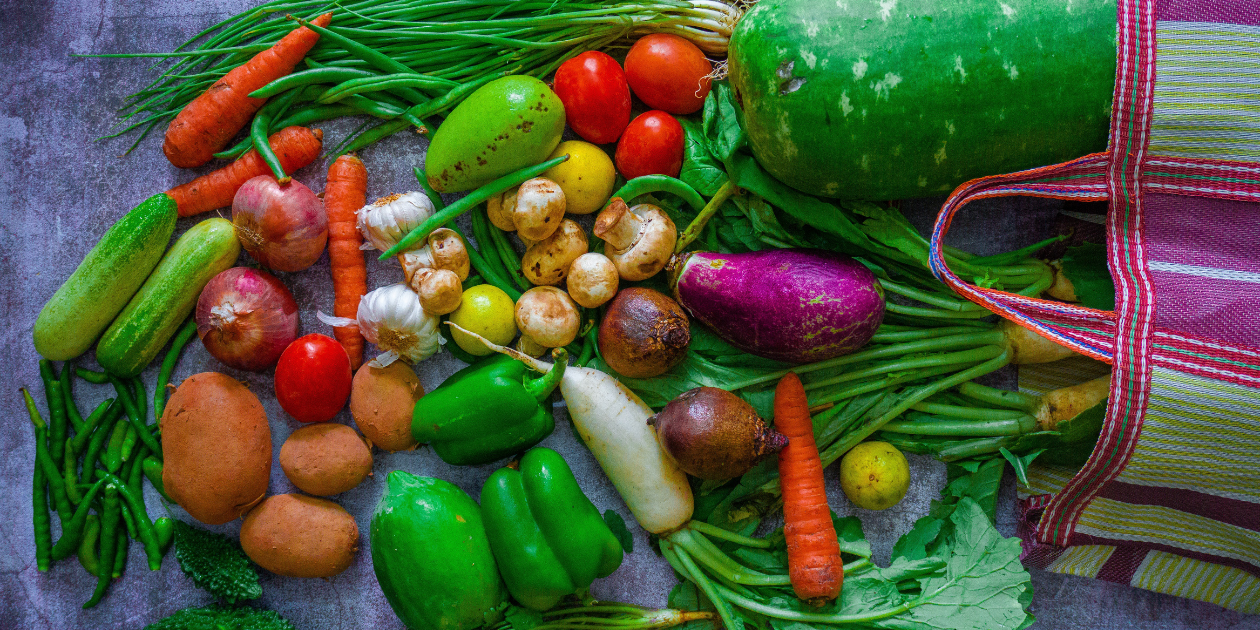Seasonal Eating Demystified: Why It Matters for Your Health
Imagine a way of eating that not only tantalizes your taste buds but also aligns with the rhythm of nature, promoting health and vitality. In this exploration, we delve into the fascinating realm of seasonal eating.
As we navigate the aisles of supermarkets filled with a year-round abundance of produce, it's essential to pause and consider the wisdom embedded in aligning our diets with the changing seasons. Do we really need to eat strawberries in the middle of the winter? Or can we choose a more natural, conscious way of eating, and thinking about food?
Rethinking How We See Food: It's Seasonal!
In today's world, we're used to finding all sorts of fruits and veggies in the supermarket, no matter the time of year. It's like magic! But let's take a moment to think about where our food really comes from.
Supermarkets are filled with food from all over, making it seem like everything is available all the time. But, there's a catch—we might be losing touch with when foods naturally grow because of this constant supply. That connection to the seasons? It's slipping away.
Back in the day, people knew exactly when to expect certain fruits and veggies because they followed the seasons. But as cities grew and life got busier, we wanted our favorite foods all year long. That's when things started to shift. The rise of big cities and busy lifestyles meant we lost touch with the natural way things work.
What is Seasonal Eating?
Seasonal eating is the practice of consuming foods that are naturally harvested during their peak seasons, aligning with the cycles of nature to maximize freshness, flavor, and nutritional benefits.
Know What's in Season: Familiarize yourself with what fruits and vegetables are in season in your area. You can do this by visiting local farmers' markets, joining a community-supported agriculture program, or even growing your own produce.
Let's break it down—what's on your plate changes with the seasons.
Here's a more detailed look:
Spring:
Spinach: Enjoy it fresh in salads or throw it into a smoothie for a nutrient boost.
Asparagus: Roast, grill, or steam for a tasty side dish that screams spring.
Strawberries: Eat them on their own, toss them in a fruit salad, or blend them into a refreshing smoothie.
Radishes: Slice into salads or enjoy with a sprinkle of salt as a crunchy snack.
Peas: Add to pasta, rice dishes, or simply enjoy them as a standalone side.
Artichokes: Steam or grill and savor the tender heart of this unique vegetable.
Lettuce (Various Types): Create vibrant salads with different lettuce varieties for texture and flavor.
Summer:
Tomatoes: Slice for sandwiches, toss in salads, or make a fresh and flavorful salsa.
Corn: Grill, boil, or enjoy corn on the cob with a touch of butter and seasoning.
Berries (Blueberries, Raspberries, Blackberries): Snack on them, add to yogurt, or top off your morning cereal.
Zucchini: Grill, sauté, or spiralize into noodles for a light and versatile dish.
Bell Peppers: Slice into strips for a crunchy snack or use in fajitas, salads, or stir-fries.
Cucumbers: Slice into refreshing salads or make your own cucumber-infused water.
Peaches: Eat them fresh, add to desserts, or grill for a delightful summer treat.
Autumn:
Pumpkins: Roast for a savory side, puree for soups, or bake into pies and muffins.
Butternut Squash: Dice and roast, blend into soups, or make creamy pasta sauces.
Apples: Snack on them, slice into salads, or bake into warm, comforting desserts.
Sweet Potatoes: Roast, mash, or use in soups and stews for a hearty autumn meal.
Cranberries: Add to sauces, bake into muffins, or sprinkle on top of salads.
Brussels Sprouts: Roast or sauté for a crispy, flavorful side dish.
Pears: Enjoy fresh, slice into salads, or poach for a sweet and tender dessert.
Winter:
Carrots: Roast, steam, or enjoy them raw with hummus as a snack.
Parsnips: Roast alongside other root vegetables for a hearty winter side.
Cabbage: Shred for coleslaw, sauté, or make hearty cabbage rolls.
Brussels Sprouts: Roast with balsamic glaze for a flavorful winter dish.
Kale: Massage with dressing for a hearty salad or throw into soups and stews.
Citrus Fruits (Oranges, Grapefruits): Eat fresh, make citrus salads, or squeeze into refreshing juices.
Potatoes: Mash, roast, or bake for classic winter comfort food.
Seasonal Eating for a Healthier You
Seasonal eating has several health benefits. Firstly, seasonal food is fresher, tastier, and more nutritious as it hasn't traveled far. Pesticides, waxes, and preservatives are often used to preserve foods that are out of season as vegetables start losing their nutrients straight after they're picked. So the quicker they get to your plate, the better. Secondly, seasonal eating encourages a varied diet, which is important for getting important vitamins and minerals. Additionally, the quality and freshness of in-season produce are better than out-of-season produce. Because demand for certain crops is high year-round, seasonal eating is a sustainable way of changing your diet that has health advantages. Thirdly, seasonal eating saves money as locally sourced vegetables won’t need storage and have smaller traveling expenses, which means that saving is passed on to the consumer.
1. Immune System Boost:
Eating seasonally provides a natural way to support your immune system. Seasonal fruits and vegetables are rich in vitamins, minerals, and antioxidants that vary with the changing seasons. For instance, vitamin C-packed citrus fruits in winter or beta-carotene-rich squash in autumn can give your immune system the extra boost it needs to fend off illnesses.
2. Heart Health Harmony:
Many seasonal foods, such as berries in summer and leafy greens in spring, are heart-friendly powerhouses. These foods are often low in saturated fats and high in fiber, antioxidants, and nutrients that promote cardiovascular health.
3. Nutrient Density Amplified:
Seasonal produce is harvested at its peak, ensuring maximum nutrient density. These nutrients, ranging from vitamins and minerals to phytonutrients, are essential for various bodily functions.
4. Reduced Exposure to Harmful Substances:
Locally sourced, seasonal foods often undergo less processing and have a shorter time between harvest and consumption. This reduces the likelihood of exposure to preservatives, pesticides, and other potentially harmful substances, contributing to better overall health.
5 . Enhanced Digestive Health:
Seasonal foods are more likely to be in sync with your body's natural digestive rhythms. For example, the presence of fiber-rich fruits in summer can aid in hydration and digestion, while the fiber in root vegetables during colder months supports digestive regularity.
Cultivating the Farmers' Market Habit
Now that we've explored the beauty of seasonal eating, let's talk about how to make it a part of your lifestyle. One fantastic way to embrace the seasons is by becoming a regular at your local farmers' market. Here's why and how:
Why Farmers' Markets?
Freshness at its Peak:
At farmers' markets, you get the cream of the crop. The produce is often picked at its peak ripeness, meaning it's not only delicious but also packed with nutrients.
Supporting Local Farmers:
By shopping at farmers' markets, you directly contribute to the local economy. You support the hardworking farmers in your community, fostering a sustainable food system.
Reducing Environmental Impact:
Locally sourced food has a smaller carbon footprint as it doesn't need to travel long distances. Choosing local means you're making an eco-friendly choice.
Would you like us to tackle some seasonal recipes next? Write to us in the comment section!





